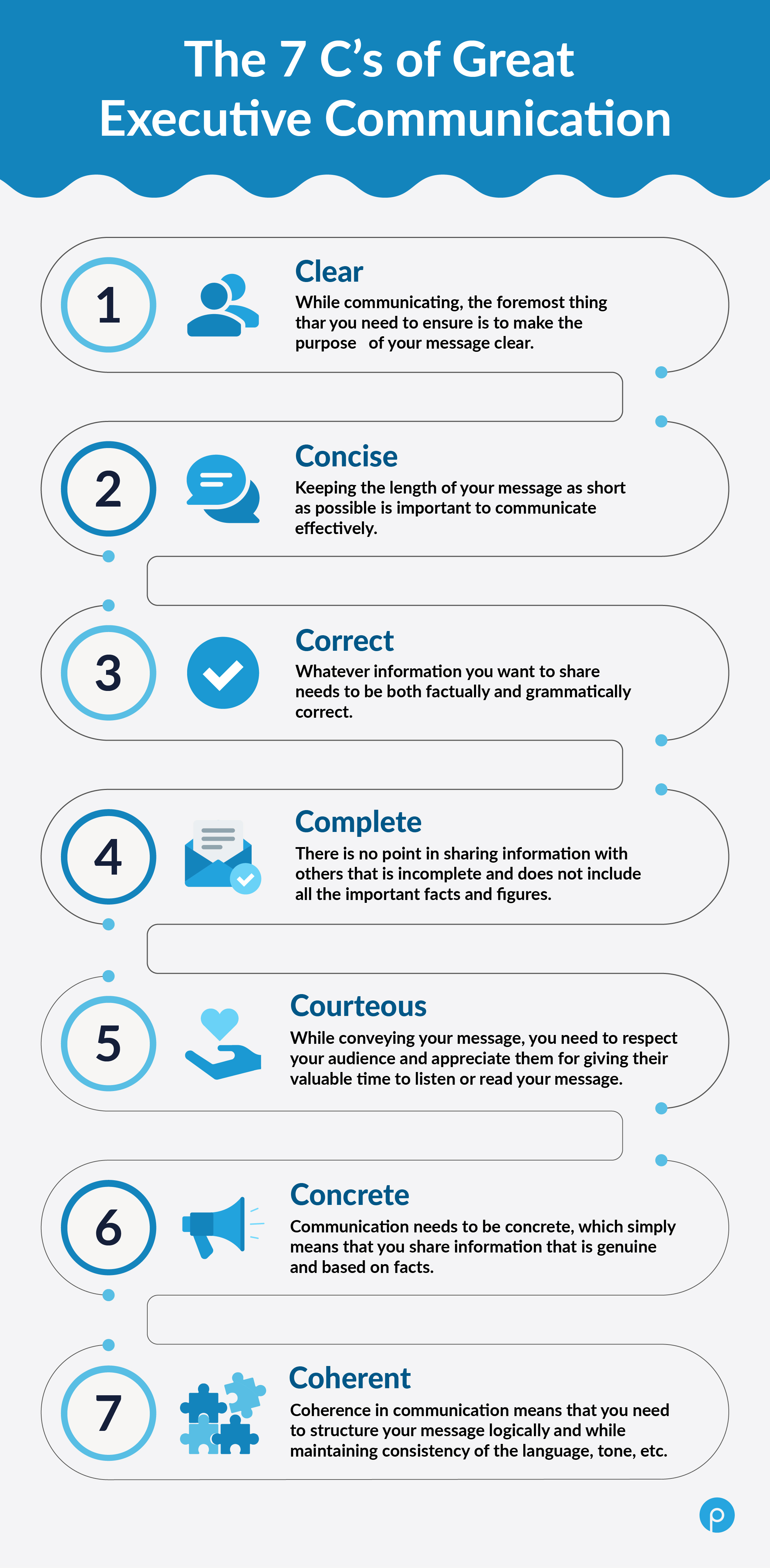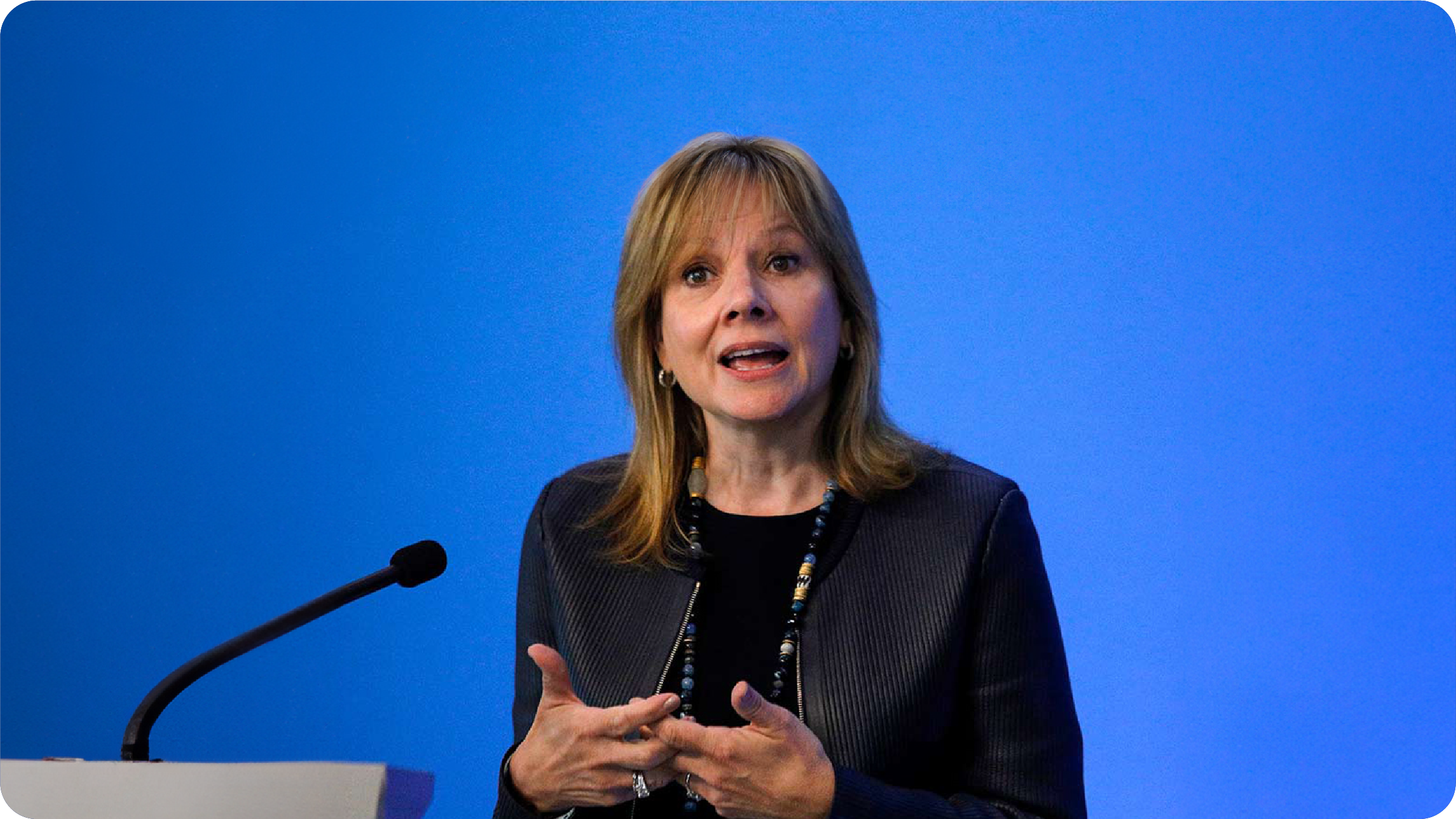The powerhouse of leadership: Effective executive communication

Imagine you're the captain of a ship, steering it through the challenging waves of business. Your team looks to you for guidance and confidence. The way you talk and listen can mean the difference between a smooth journey and trouble at sea. That's the power of executive communication, a key skill every leader needs to succeed. How effectively do you think you're communicating as a leader? Let's go through this article and check.
What is executive communications?
Executive communication is all about how an executive team shares their ideas, plans, and messages with everyone, from team members to the whole world. It’s much more than just giving out information; it’s about having real conversations. Good leaders know how to talk so people will listen, and listen so people will talk. This skill helps build strong relationships, push plans into action, and keep everyone moving in the same direction. When you're in charge, how well you communicate can really set the tone for your team’s success.

Components of executive communication
Vision and strategy: Painting the bigger picture
A leader's job is much like that of an artist, carefully crafting and sharing the organization's future vision and strategy. It’s not just about setting goals; it’s about inspiring everyone with a vivid story that makes each team member eager to play their part. This shared vision guides and motivates the team, giving everyone a sense of purpose and direction.
Stakeholder engagement: Building bridges
Effective leaders know the importance of robust connections with all stakeholders—employees, customers, investors, and the media. By fostering open lines of corporate communication, leaders encourage valuable feedback and align everyone’s efforts with the organization’s goals. This proactive engagement keeps relationships strong and collaborative.
Crisis management: Steering through storms
In times of crisis, a leader's ability to communicate clearly and calmly is crucial. Honest, transparent messages that address challenges while also offering hope and reassurance are essential. This approach not only manages the situation at hand but also secures ongoing trust and credibility.
Internal communication: Uniting the crew
It's about ensuring that all messages are clear, consistent, and motivating. Effective communication fosters an inclusive atmosphere where every employee feels valued and driven to contribute their best. This unity helps the organization move smoothly and efficiently toward its goals.
Importance of executive communication
Effective executive communication goes beyond mere exchanges of information—it’s a vital tool for building a strong organizational foundation. Here's why it matters:
Building trust and credibility: When leaders communicate with transparency and consistency, they do more than just share information; they build trust. This trust is fundamental in establishing their credibility with their teams, interested parties, and customers. People are more likely to follow and invest in leaders who they believe are honest and reliable.
Driving engagement and motivation: Communication is powerful—it can motivate and engage. When leaders articulate the organization's goals clearly and connect them to individual roles, it lights a fire of commitment among team members. This clear connection gives everyone a personal stake in the success of the organization, driving them to give their best.
Navigating change and uncertainty: Change is a constant in any organization, and how leaders communicate during these times makes all the difference. Effective communication reduces anxiety and manages uncertainties, smoothing the transition process. It ensures that everyone moves in sync, even when the future seems unclear.
Enhancing decision-making: Good communication also enhances decision-making. When leaders communicate effectively, they are better able to gather input, facilitate meaningful discussions, and make well-informed choices. This not only improves outcomes but also strengthens stakeholder buy-in, as people feel their voices are heard and valued.
Strengthening organizational culture: Lastly, the way leaders communicate can deeply influence the organizational culture. Leaders who prioritize open and honest communication foster an environment of trust, accountability, and continuous improvement. This kind of culture not only attracts talent but also retains it, as employees feel valued and part of a thriving community.
How to create an executive communications plan & strategy?
Creating a strategic executive communications plan is more than a series of tasks—it's crafting a roadmap that guides leaders in consistently and effectively reaching their audiences. Building a structured approach to the strategy of communications includes:
Defining objectives
Begin by establishing clear, strategic objectives for your communications. These should be tightly aligned with the organization's overarching goals and tailored to meet the needs of different key players. Whether it's educating employees about new company initiatives, inspiring stakeholders to embrace a vision, or managing your organization's public image, each objective should serve a distinct purpose.
"By failing to prepare, you are preparing to fail." - Benjamin Franklin
Setting the right objectives is the first step in ensuring your communications will succeed.
Crafting key messages
At the heart of your strategy are the key messages. These should encapsulate what you stand for and convey your priorities clearly and compellingly. Think of these messages as your organization's voice in a crowded room—what do you need to say to be heard and remembered? Ensure these messages are:
- Clear: Simple language beats jargon every time.
- Consistent: Uniform messages reinforce trust and recognition.
- Relevant: Tailor messages to resonate with specific audience interests and needs.
Selecting communication channels
Choosing the right channels is crucial for effectively reaching your audience. Each channel has its strengths and is suited for different types of messages and interactions:
- Face-to-face meetings: Ideal for crucial conversations where direct interaction is beneficial.
- Emails and newsletters: Best for detailed, non-urgent communications that require thorough reading.
- Social media: Great for broad reach and real-time engagement.
- Presentations: These are effective for delivering impactful thoughts in a structured format, ideal for engaging multiple key players.
- Internal platforms: Use intranets and digital collaboration tools to foster a cohesive internal community.
Evaluating effectiveness
"Without data, you're just another person with an opinion," - W. Edwards Deming
Measuring the impact of your communications is essential. Collect feedback through surveys and interviews to gauge audience perception. Analyze engagement metrics like open rates and social interactions to understand what captures attention. Regularly adjust your strategies based on these insights to enhance the effectiveness of your communications.
This strategic approach ensures that your executive communications reach your internal and external audiences and resonate with them, fostering a connected and motivated organizational environment.
Executive communication skills
Effective executive communication requires a range of skills. Mastering these skills enables leaders to connect with their audience, convey their messages clearly, and inspire action.
Key communication skills
Active listening
Truly great CEOs and C-suite leaders listen to understand, not just to respond. Active listening involves paying full attention to others, acknowledging their views, and responding thoughtfully.
Pro-tip: In your next meeting, focus solely on understanding the speaker’s point without thinking about how you'll respond. This practice can deepen your listening skills.
Clarity and conciseness
In a world flooded with information, being clear and concise is more important than ever.
Pro-tip: Before communicating, distill your message to its core. Ask yourself, "What is the one thing I need my audience to remember?"
Empathy & emotional intelligence
This involves being aware of and controlling one’s emotions and understanding the emotions of others. It's crucial for navigating the complexities of human relationships in a professional setting.
Pro-tip: Regularly reflect on emotional interactions and consider what went well and what could be improved. This self-reflection will enhance your emotional awareness.
Adaptability
Different situations and audiences require different communication approaches. Executives must be adaptable, tailoring their communication style to the context and audience.
Pro-tip: Before you speak, tailor your communication style to your audience by considering their needs, expectations, and background.
Storytelling
A well-told story can transform abstract concepts into relatable, memorable experiences.
Pro-tip: Use real-life examples that embody your key messages. This not only makes your communication more engaging but also more credible.
Best practices to develop thought leadership communication skills
Aspiring thought leaders must continuously refine and enhance their abilities to truly stand out and make an impact. Here’s how executives can develop skills that not only convey messages effectively but also establish them as thought leaders in their field.
Advanced training and workshops
Beyond basic communication workshops, seek out advanced training programs that delve into the nuances of persuasive and strategic communication. These programs often incorporate the latest research in cognitive psychology and behavioral economics to teach leaders how to craft messages that resonate on a deeper level.
Pro-tip: Enroll in a workshop that uses real-time feedback technology, allowing you to see the immediate impact of your communication styles and adjust accordingly.
Strategic coaching and mentoring
One-on-one coaching with a focus on communication can transform good leaders into great influencers. A seasoned coach can help refine your message delivery, ensuring it aligns with your personal leadership style and your organization's strategic objectives.
Pro tip: Choose a mentor who has a proven track record in your industry or a similar field and who is recognized for exceptional conversational skills. This specificity can provide relevant insights and actionable advice that generic coaching might overlook.
Targeted practice and experience
To truly excel, integrate communication practice into your daily routine. Seek opportunities that push you out of your comfort zone and expose you to new audiences and challenging scenarios.
Pro-tip: Create a personal challenge to speak at diverse venues, from industry conferences to local community events. Each setting tests different aspects of your conversational skills, such as adapting your message for different audiences or handling unexpected questions.
Practical needs of effective executive communication
Effective executive communication addresses several practical needs within an organization. It ensures that the right information is conveyed to the right people at the right time, fostering a culture of transparency, trust, and collaboration.
Ensuring clarity and understanding
- Clear objectives: Setting clear objectives for communication helps ensure that the message is focused and relevant.
- Simple language: Using simple and straightforward language makes the message more accessible and easier to understand.
- Visual aids: Incorporating visual aids, such as charts, graphs, and images, can help convey complex information more effectively.
Building trust and credibility
- Transparency: Being open and honest in communication builds trust and credibility with the audience.
- Consistency: Consistent messaging across all channels and communications reinforces trust and reliability.
- Follow-through: Following through on promises and commitments made during communication strengthens credibility.
Engaging and motivating teams
- Involvement: Involving employees and stakeholders in the communication process fosters a sense of ownership and engagement.
- Recognition and appreciation: Recognizing and appreciating contributions through communication boosts morale and motivation.
- Interactive communication: Encouraging two-way communication and feedback creates a more dynamic and engaging environment.
Executive communication style
An executive's communication style significantly influences how their messages are both received and perceived. To ensure your communication is as effective as possible, it should reflect your personality, align with organizational culture, and meet the audience's needs.
"The art of communication is the language of leadership,"
notes James Humes, highlighting its critical role in effective leadership teams.
Types of leadership communication styles
- Authoritative: Clear, decisive, and confident—this style commands attention and instills confidence. Example: When a CEO announces a major company restructuring, using an authoritative tone can help clarify the vision and reassure employees about the future.
- Participative: This style is all about inclusion and collaboration. By inviting input and fostering teamwork, leaders build ownership and enthusiasm. pro-tip: Use participative communication during team meetings to generate ideas and solutions, enhancing the collective commitment to projects.
- Transformational: Transformational leaders inspire by communicating a compelling vision that encourages innovation and drives change. As Steve Jobs famously said, "The people who are crazy enough to think they can change the world are the ones who do." This style is particularly effective in motivating teams to reach ambitious goals.
- Transactional: Practical and straightforward, this style focuses on specific tasks and goals. It’s especially effective in day-to-day management to keep teams on track. pro-tip: Regularly use transactional communication in status updates to keep everyone aligned and focused on immediate tasks.
Adapting communication style
- Audience awareness: Knowing your audience is key. Adapt your style to fit the cultural and emotional context of your listeners, ensuring your message is not only heard but felt.
- Situational flexibility: The best leaders pivot their communication style according to the situation. Example: Switch to an authoritative style during a crisis to guide and reassure your communications team.
- Self-awareness: Continuously reflect on and adjust your communication style based on feedback. "Feedback is the breakfast of champions," Ken Blanchard reminds us. Use it to refine your approach and enhance your leadership presence.
Executive communication examples
Examining real-world examples of effective executive communication provides valuable insights into best practices and strategies.
Satya Nadella at Microsoft
When Satya Nadella became CEO of Microsoft in 2014, the company was seen as lagging behind competitors in innovation. Nadella’s communication style played a pivotal role in transforming Microsoft’s culture and strategy.

- Empathy and inclusiveness: Nadella emphasized empathy and inclusiveness in his communication, fostering a culture of collaboration and innovation.
- Clear vision and strategy: He clearly articulated a vision for the company’s future, focusing on cloud computing and AI, which aligned the organization towards common goals.
- Transparency and accountability: Nadella’s transparent communication style built trust within the organization and externally, enhancing Microsoft’s reputation and performance.
Mary Barra at General Motors
Mary Barra, CEO of General Motors, has demonstrated the power of effective communication in navigating crises and driving transformation.

- Handling crisis with honesty: During the ignition switch recall crisis, Barra communicated openly and honestly, taking responsibility and outlining clear actions to address the issue. This approach helped rebuild trust with customers and stakeholders.
- Driving change: Barra’s communication has been pivotal in driving GM’s transformation towards electric and autonomous vehicles. She has clearly communicated the company’s vision and strategy, inspiring employees and stakeholders to embrace the change.
Arne Sorenson at Marriott International
Arne Sorenson, the late CEO of Marriott International, exemplified compassionate and transparent communication during the COVID-19 pandemic.

- Compassion and empathy: In a video message to employees, Sorenson expressed deep empathy for the difficulties faced by employees and the hospitality industry. His heartfelt message resonated widely, building trust and solidarity.
- Transparency: Sorenson was transparent about the impact of the pandemic on the company and the tough decisions that had to be made. This honesty helped manage expectations and maintain credibility.
- Reassurance and hope: Despite the challenges, Sorenson’s communication was infused with hope and reassurance. He highlighted the company’s resilience and the steps being taken to navigate the crisis.
Future trends in executive communication
As we look to the future, several emerging trends are poised to reshape the landscape of executive communication. These trends highlight the evolution of technology and the growing importance of human connection within the workplace.
- Increased use of AI and data analytics: The integration of AI and data analytics in communication strategies is becoming increasingly prevalent. Tools like Prezent are revolutionizing how executives craft and deliver their messages through presentations by leveraging data to understand audience preferences and measure engagement. This technology enables leaders to tailor their communication effectively, ensuring it resonates with their audience on a deeper level.
- Greater emphasis on empathy and emotional intelligence: The need for empathy and emotional intelligence has never been more pronounced. As workplaces become more diverse and the global business environment more interconnected, executives must communicate with sensitivity and awareness. This approach fosters a more inclusive culture and enhances employee engagement by showing that leaders value and understand the varied experiences of their teams.
- Hybrid and remote communication: The shift towards hybrid and remote work environments is not just a temporary adjustment but a permanent change for many organizations. This trend requires executives to rethink their communication strategies to ensure they remain effective across digital divides. It involves not only choosing the right tools and platforms for virtual communication but also adapting messaging to keep remote and hybrid teams engaged and aligned with organizational goals.
- Sustainability and Social Responsibility: In an era where transparency is paramount, stakeholders are increasingly holding companies accountable for their impact on social and environmental issues. Executives must be adept at communicating not just the financial aspects of their business but also their efforts and achievements in sustainability and social responsibility. This transparency helps build trust and strengthens the company's reputation in the market.
Ways in which Prezent supports senior leaders in effective communication
Prezent is designed to significantly enhance the efficiency and effectiveness of executive communication through its advanced AI-driven features and tools. This platform not only simplifies the creation of presentations but also ensures they are impactful and aligned with corporate branding.
- Hyper-Personalized content generation: Prezent uses ASTRID AI to auto-generate content that is tailored to the specific needs and styles of each user. This feature helps in crafting presentations that are not only on-brand but also resonate well with the intended audience.
- Template converter: This tool is invaluable for maintaining brand consistency across all communications. It automatically aligns presentations with brand guidelines, ensuring that every slide reflects the corporate identity. This not only saves significant time but also enhances the professionalism of the presentations.
- Synthesis for executive summaries: The Synthesis tool simplifies the creation of executive summaries by extracting key insights and condensing complex information into clear, concise points. This aids in making the core messages of presentations more accessible and understandable to all stakeholders.
- Structured storytelling and training: Prezent empowers users with structured storytelling capabilities, which are essential for effective business communication. Additionally, the platform includes on-demand learning modules that help improve communication skills, ensuring messages are delivered clearly and effectively.
- Comprehensive communication platform: Beyond just presentation tools, Prezent offers a suite of features to enhance overall communication productivity. This includes a slide library, story builder, auto generator, and courses on business communication. These resources equip executives with the tools to deliver messages that are not only visually appealing but also strategically impactful.
To see how Prezent can transform your executive communication, consider exploring these features firsthand with a 14-day free trial or schedule a free demo with our experts on your own time.



.avif)








